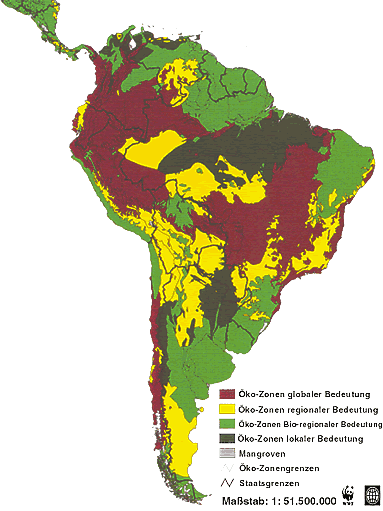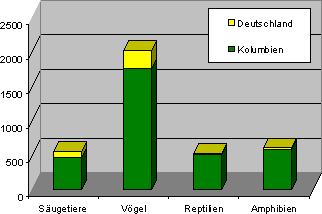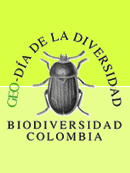|

Colombia
is mega. Located in
the north-west of South America, it is one of what have been called the
five "megadiverse countries" in the world, i.e. countries that possess
an exceptional wealth of plant and animal species - known as a ![]() biodiv
hotspot. We only need to look a few figures to realise just how special
Colombia is.
biodiv
hotspot. We only need to look a few figures to realise just how special
Colombia is.
Stretching from the Pacific Ocean to the Caribbean Sea, the country covers
"only" 0.8% of the world's land surface, yet, with between 45,000 and
51,000 species, it is home to some 15% of the all plant species in the
world. And with1,752 bird species and 583 amphibians, Colombia has a biodiversity
of fauna unrivalled by any other country. Moreover, in terms of the number
of species of flora that only occur in one specific region, the so-called
endemic species, Colombia is also a world leader.
|
Categoriy |
World ranking for Biodiversity |
Number of indigenous species |
World rankings for endemic species |
|
Higher Plants |
2 |
15000-17000 |
3 |
|
Vertebrates (except fishes) |
1 |
634 |
3 |
|
Mammals |
3 |
28 |
13 |
|
Birds |
1 |
142 |
5 |
|
Reptiles |
3 |
97 |
11 |
|
Amphibians |
1 |
367 |
1 |
|
Butterflies |
3 |
300 |
4 |
|
Source: Mittermeier et al.: Megadiversity, CEMEX, Mexico City, 1997 |
|||
One reason for this huge wealth of biological resources is the wide variety of landscapes across Colombia. The country has 18 different "ecosystem regions" with 65 different ecosystems, covering an area of 1.14 million km². Colombia is the second most biologically diverse country in Latin America. And this does not even take into account the richness of biodiversity in the Chocó region near the Pacific and in the peripheral parts of the Orinoco plains and Amazonia - for the biosphere here is still largely unexplored.

Data on biodiversity in Colombia
|
REGION |
Mammals |
Birds |
Reptiles |
Amphibians |
Total |
|||||
|
No. |
% |
No. |
% |
No. |
% |
No. |
% |
No. |
% |
|
|
Amazonia |
85 |
19 |
868 |
50 |
147 |
29 |
134 |
23 |
1234 |
37 |
|
Orinoquia |
101 |
22 |
644 |
37 |
119 |
24 |
41 |
7 |
905 |
27 |
|
Caribbean |
100 |
22 |
951 |
54 |
101 |
20 |
28 |
5 |
1180 |
36 |
|
Pacific |
167 |
37 |
830 |
47 |
210 |
42 |
181 |
31 |
1388 |
42 |
|
Andes |
177 |
39 |
974 |
56 |
277 |
55 |
353 |
61 |
1781 |
54 |
|
Germany |
98 |
0 |
273 |
0 |
12 |
0 |
19 |
0 |
395 |
0 |
|
Colombia total |
454 |
0 |
1752 |
0 |
506 |
0 |
583 |
0 |
3295 |
0 |
Biodiversity
of Germany - Colombia in comparison

Source: Instituto de Investigación de Recursos Biológicos Alexander von Humboldt. "Informe Nacional sobre el Estado de la Biodiversidad en Colombia". Santafé de Bogotá, Kolumbien, 1998
Yet although Colombia has this high diversity of species, it is being destroyed at an alarming rate. The country is currently going through a process of rapid change, which is causing considerable damage to its uniquely diverse biosphere. The reasons for the loss of biological resources are manifold: a lack of appreciation of the value of biodiversity at the political level and insufficient scientific knowledge play a role in this situation, as do factors like inappropriate land use, the incursion of arable farming and the illegal plantation of drug crops. Moreover, the cutting down of forest for fuelwood and to supply the timber trade are resulting in a particularly serious loss of biodiversity. It is now estimated that the loss of forest cover across the country already amounts to 40%.
The Colombian government ratified
the United Nations ![]() Convention
on Biological Diversity (CBD)
in 1994, not least in response to this dramatic loss of biological resources.
The CBD sets out an international legal framework for promoting conservation,
knowledge and the sustainable use of biodiversity. The signatory states
pledge to pursue a fair and equitable sharing of the benefits arising
out of the utilisation of biological resources and the related knowledge,
innovations and practices of national science, industry and local communities.
Convention
on Biological Diversity (CBD)
in 1994, not least in response to this dramatic loss of biological resources.
The CBD sets out an international legal framework for promoting conservation,
knowledge and the sustainable use of biodiversity. The signatory states
pledge to pursue a fair and equitable sharing of the benefits arising
out of the utilisation of biological resources and the related knowledge,
innovations and practices of national science, industry and local communities.
In addition, the Convention on Biological Diversity calls for international
cooperation between the countries with rich but threatened biosphere resources
and the industrialised countries in order to promote protection, scientific
research and sustainable development. This is the background to the close
cooperation of recent years between the Federal Republic of Germany
and Colombia.

